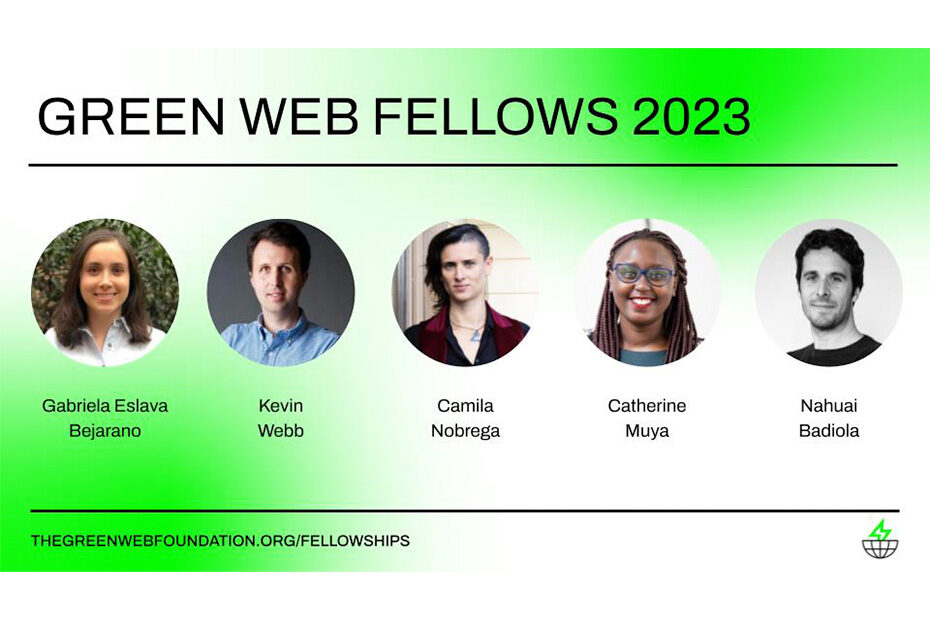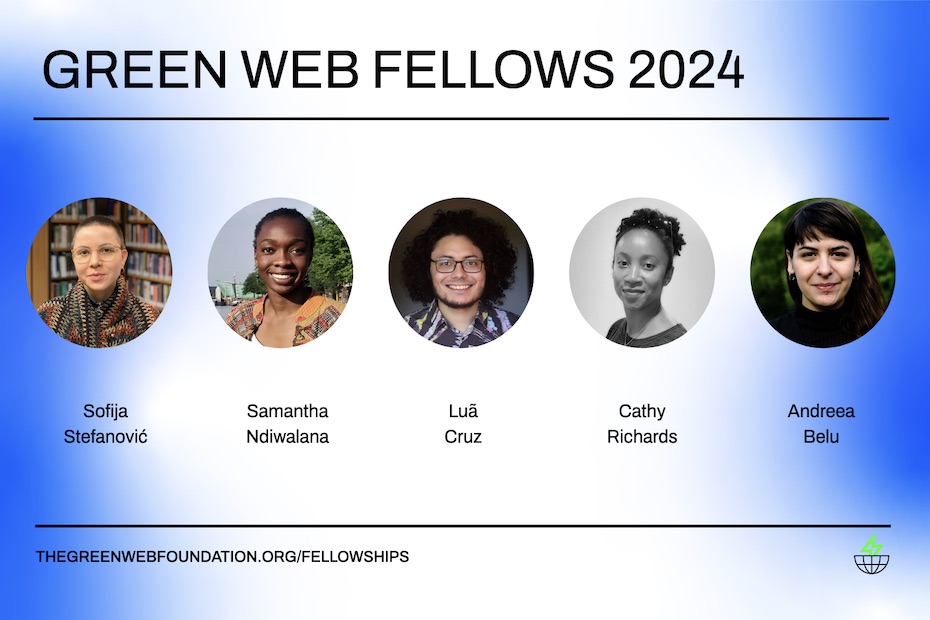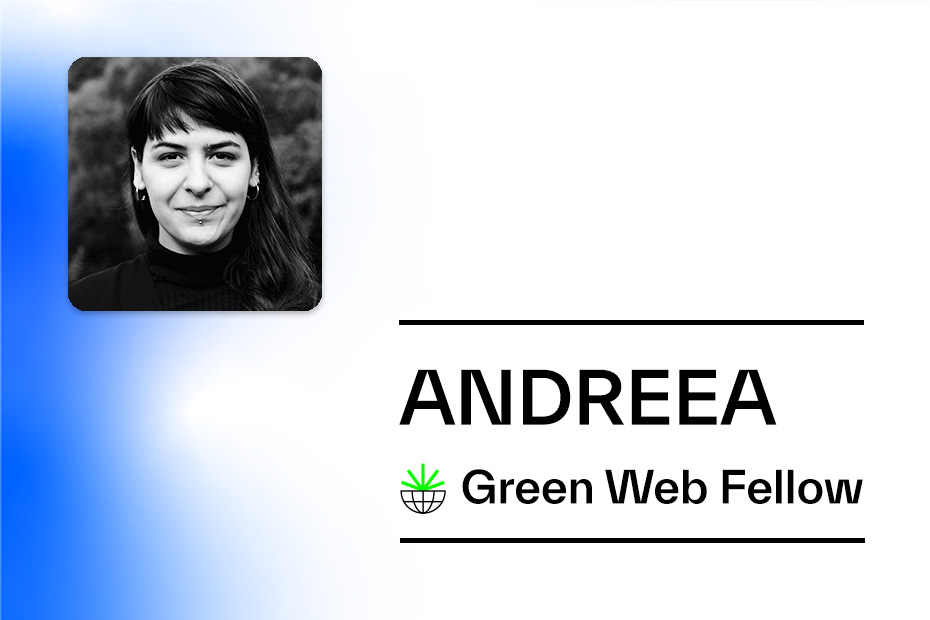Our 2023 fellowship ran between Feb and Oct 2023. During that time, our five fellows, Camila, Catherine, Gabriela, Kevin and Nahuai learned together about the intersection of digital rights and climate justice. One of the aims of the fellowship is to openly and honestly explore new ideas about what powers control the internet, how it is fueled, and what we can do about it.
But it’s not just our fellows that learn throughout this process. We all do. Those of us working at Green Web Foundation, those involved in making the fellowship happen through funding or guest speaking, or those following along also learn by proxy.
In this blog we reflect on a few of the things each of the fellows shared and taught us. Things that got us thinking differently about how digital rights and climate justice overlap. We also collate the outputs from the fellows into one handy place.
Camila Nobrega
Quick recap
Introducing Camila. Camila’s posts:
- Feminist Architectures of Investigations on Megaprojects
- So… How does a submarine cable look like and what does it have to do with environmental justice?
- A social technology of investigations through encounters. My trajectory as a green web fellow
- Sharing methods, Working with material(s)
Camila’s project: ‘Have you seen a submarine cable’ workshop, encounters to build collective investigations, starting from specific cases like a submarine cable that was damaged.
Further work – beyondthegreen.media
A few things that resonated with us
Grounding the fellowship project in a story
An internet cable that broke down, and denied the island of Toga internet for weeks. Telling one story heard from multiple perspectives can be powerful, but opening spaces to build a new process of investigation and collaboration as a first step can be even more powerful. This kind of storytelling shows the need to work at this intersection, and also shows how important it is to engage people accordingly.
“Materialising” the internet is a good strategy to bring awareness to these topics
Infrastructure. Megaproject. Big words that seem distant. But that in practice depend on land, territory, water, and other common goods. That´s how it works with any large-scale project, the result of massive demands, such as hydropower dams, mining sites. So it happens with the internet, and all the data infrastructure around it.
“Have you ever seen a submarine cable anyway?”
Submarine cables sustain more than 90% of the global internet infrastructure. While many studies focus on security issues behind it (such as this publication by the European Parliament from 2022), there is a lack of research on connections between digital infrastructure and its own dependency on other mega structures. Namely, energy generation, mineral extraction, land ownership.
Catherine Muya
Quick recap
Introducing Catherine. Catherine’s posts:
- A step into the green direction
- Africa needs stronger collaboration towards greener digital transformation
- Walking a greener path: Summary of my experience as a Green Web Fellow
- Digital policy and Climate Justice
Catherine’s project – Safer Green Voices – finds out the existing challenges of digital safety and security of climate activists in sub Saharan Africa.
A few things that resonated with us
The digital rights community has a blind spot on climate justice
Whilst working as a program officer at ARTICLE 19, Catherine observed that none of her work looked directly at climate activists or how they were engaging with the digital environment. Nor has she come across such information from partners. She demonstrated that the digital rights community has a lot of knowledge, but it’s sometimes not disseminated to communities that need it. The fellowship definitely ignited her desire to walk down this digital path illuminating the greening star (in her own words!).
Different ways in which the digital transformation intersects with climate in Africa
Digital transformation in Africa is projected to lead to economic growth of up to $180 billion by 2030. However, it is estimated that the ICT sector contributes at least 1.4% of global greenhouse gas emissions. The International Renewable Energy Agency also reports that several African countries are making steps through creation of policies, regulations and investment promotion to use renewable energy such as solar, wind and Hydro energy. For example, Kenya has more renewable generation than Iceland and many other places. Digitalisation increases the types and frequency of digital risks to climate activists as well.
New doors for collaboration
The intersection of climate justice and digital rights is opening doors to new collaborations. For example through MozFest Kenya and Catherine’s new role at GIZ that is looking into emissions/ environmental impact of technology in Sub-Saharan Africa.
Gabriela Eslava Bejarano
Quick recap
Introducing Gabriela. Gabriela’s posts:
- What happens after climate litigation and activism, and how did I end up here?
- Digital Transformation and Climate Action: Still in the Clouds?
- A Door into the Clouds Lab
- Digital rights and Climate Justice in Latin America
Gabriela’s project – In the Clouds Lab, an experimental digital ‘place’ for dialogue to explore how digital rights can be a tool for climate justice, especially when thinking about climate adaptation and the limits and challenges this may have.
A few things that resonated with us
Strategic litigation needs to follow enforcement to make the most of the victory
A key insight was around the limitations of strategic litigation, and understanding what the aftermath looks like – we learned this from Gabriela’s experiences in Colombia. You can take a court battle on climate all the way to a supreme court, and win. But if the court judgement doesn’t lead to a robust remedy, there’s a risk that the victory ends up feeling somewhat hollow, and hard to enforce effectively.
Global North has “too much internet” at point of use, global south “doesn’t have enough” – the degrowth argument applied to connectivity
This came up a few times. Much of our fellowship has pursued the direct impacts of tech. But the question of access to digital services and information asymmetry came up. When people in the so-called global north talk about the harms of tech, it’s easy to interpret it as meaning the people who already struggle to have access to information or connectivity should have less too.
There is still very little awareness about the environmental impact of digital infrastructure
For non-experts and common people, both climate change and digital rights seem abstract and somehow ephemeral topics. Both subjects seem to be taking place in the clouds and are hard to digest. Gabriela developed creative ways to share a more nuanced understanding of the issues at stake, and what kind of perspectives and pitfalls digital infrastructure or “the internet” can have through.
Kevin Webb
Quick recap
Introducing Kevin. Kevin’s posts:
- The link between public infrastructure and digital rights in decarbonization
- The Right to Repair in a Platform-Powered World
- Putting the Internet Back in the Things
- Discovering new approaches to internet infrastructures
Kevin’s project – Hydrogen Plumbing – rewires connectivity for low-power, low-bandwidth devices, leveraging existing Internet standards, building on unlicensed radio spectrum, and open hardware reference designs.
Project website – https://hydrogen.plumbing/
A few things that resonated with us
Data centres are best thought of as a form of heavy industry
This was an insight from Kevin and his earlier work, and follows on from a post by previous Green Web Fellow Fieke Jansen about data centres as a site of conflict. If we compare data centers to other deployments of industry in communities there’s a whole new playbook of responses to refer to.
The internet of things doesn’t really work much like the internet.
Or not as much as you would think from the name. If anything it’s modeled after the centralised approaches of telecoms or cloud providers, and many of the business models were built on the expectation of achieving tech firm-like profit margins. Kevin’s example of the e-bikes being built with connectivity as one of the most expensive parts of a system is an example, and their subsequent bricking once the companies go out of business. This dependency was designed to be the way to achieve the profits.
Approach technology from a justice perspective rather than a user perspective
Since the fellowship, Kevin says he’s been able to step back and focus his work on the outcomes that we need to be working towards. It has opened up new questions, such as how internet infrastructure is related to climate and mobility justice – something he says he was simply not taking into consideration before.
His work also shifted in terms of practicality. Before, he was interested in the bigger questions of internet infrastructure, such as what should the internet look like? Right now, he’s working on concrete solutions that enable mobility and create livable urban environments. He’s changed his focus towards the actual needs of communities, and is asking: How can we create just and sustainable mobility solutions?
Nahuai Badiola
Quick recap
Introducing Nahuai. Nahuai’s posts:
- New experience as a fellow
- 4 lessons I learned from facilitating a digital sustainability workshop at Mozfest
- Sustainability as an umbrella term
- My experience as Green Web fellow: last chapter
- WordPress, sustainability and learning in the open
Nahuai’s project – Sustain WP – a limited podcast series about digital sustainability and WordPress.
Project website – https://sustainwp.com/.
A few things that resonated with us
Sustainability has different connotations in different contexts
Sustainability means different things to different people and is best thought of as an umbrella term. A lot of things can go under it. Such as the environmental impact of making software or hardware, or the knock-on social and economic considerations. The term sustainability also has a very specific connotation in open source projects; it can refer to the durability of a project. This is often considering the people who maintain and sustain projects. Not all sustainability roads lead to carbon reduction!
Running projects in parallel can be beneficial
At the same time as doing this fellowship, Nahuai was also working with others to establish the WordPress sustainability team. Recording the podcast episodes whilst forming this team was mutually beneficial, and supported the foundation of the WP Sustainability team with a broad perspective on what sustainability means across the community. It helped to communicate the broadness of what the topic might cover more clearly as well.
It’s ok to pivot
Initially Nahuai planned to run a workshop on digital sustainability at a WordPress event. But during the fellowship he realised he could have more impact recording a podcast, and this would also have more long-term benefits. Sometimes, it’s good to realise there’s a better route for getting your planned impact out there, and changing direction.
What’s next for the Green Web Fellowship?
The fellowship is back in 2024, and our five new fellows have already been selected. As in 2022 and 2023, we are supporting movement leaders who are embedded in communities impacted by digital infrastructure or they are providing open research and tools that can serve those communities.
You can follow along in our fellowship notebook.



